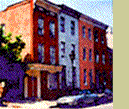


 |
Historic Preservation Guidelines & Requirements
for the Ridgely's Delight Historic District
Important Contacts Ridgely’s Architectural Review Committee CHAP Permits Office |
Forms Application for Notice to Proceed |
Published by Ridgely’s Delight Association & Ridgely’s Delight Architectural Review Committee in accordance with the guidelines of the Baltimore City Commission for Historical and Architectural Preservation (CHAP)
A. INTRODUCTION
1. To make any exterior changes to your building you need:
a. A work permit from the city.
b. A notice-to-proceed from CHAP.
2. To ensure CHAP will grant you a notice-to-proceed:
a. Follow these guidelines for any proposed work.
b. Obtain a signature from the Ridgely's Delight Architectural Review Committee.
These guidelines are based on the city-wide guidelines published by CHAP, and are tailored to the specific architecture of Ridgely’s Delight. The Ridgely’s Delight Association will gladly support any plans that follow these guidelines at CHAP hearings or negotiations.
Law Background: Ordinance No. 229 ( May 21, 1964) created CHAP, authorized the Commission to adopt regulations to transact its business, and established procedures for designating historic districts. Ordinance No. 939 (March 2, 1967) expanded CHAP’s duties and created the Landmark List.
A CHAP historic district
is defined as "an area in Baltimore City wherin,
there are  located buildings and structures which have historic,
cultural, educational and/or architectural value, the preservation of which
is deemed
to be for the
educational, cultural, economic and general welfare of the inhabitants
of Baltimore City."
located buildings and structures which have historic,
cultural, educational and/or architectural value, the preservation of which
is deemed
to be for the
educational, cultural, economic and general welfare of the inhabitants
of Baltimore City."
By law, CHAP must approve the following for any property within an historic district or for any landmark: "any excavation, construction or erection of any building, fence, wall, or other structure of any kind; or any removal of any external architectural feature, or for any reconstruction, alteration, change to exterior color by painting or other means, or for any demolition of any structure." CHAP’s approval is based upon the appropriateness of the proposed work, taking into consideration "the historic or architectural value and color of the exterior architectural features of other structures in the immediate neighborhood."
These guidelines apply in addition to all prevailing laws, and do not diminish the force of existing requirements, standards, building codes, zoning, etc. Property owners must contact the appropriate City agencies to comply with all existing codes and law.
B. WORK PERMITS & CHAP NOTICE-TO-PROCEED
Baltimore City requires
work permits for all building projects, large and small. Within CHAP
historic districts, an additional historic notice-to-proceed
is
required for all exterior work. This is especially important for demolition,
additions,
and changes, but applies equally to minor work such as paint and window
repair.
You or your contractor apply for work permits and notices-to-proceed
at the Charles L. Benton Building, 417 East Fayette St. (across from
City
Hall).
Work permit
applications are in the Permit Section Office on the 1st floor, and notice-to-proceed
applications are in the Dept. of Planning office on the 8th floor. A
representative of the Ridgely’s Delight Architectural Review Committee
must sign your notice-to-proceed application.
Extensive work such as demolition, new construction, and alterations may also require a public hearing. CHAP conducts hearings once a month. To present your proposal at a hearing, you should bring sketches, plans, photographs, or sample materials. A letter of support from the Ridgely’s Delight Association may help you gain approval.
Most new construction and building additions within Ridgely’s Delight also require zoning variances, and zoning hearings are held separately.
C. GUIDELINES
1. General Considerations.
Ridgely’s Delight is an historic neighborhood from Baltimore’s first period of growth in the 1800s. Most of its structures were built between the War of 1812 and the Civil War (1861-1865). To preserve this neighborhood for posterity, the historic district has two primary preservation goals.
The first goal is to maintain the historic streetscape—the neighborhood’s general feel and appearance. To accomplish this, the law requires you to use historic architectural practices, building materials, and colors. This goal allows a certain amount of change to individual structures. As long as the guidelines are maintained, the neighborhood’s streetscape will survive despite evolving needs and uses of individual structures.
The second goal is to preserve the neighborhood’s authenticity. Because Ridgely’s Delight is a real historic neighborhood and not just a fanciful interpretation of the past, it is important to preserve original historic material when possible.
Therefore, it is better to repair an old window than to replace it, it is better to use exact duplicate materials than mere substitutes, and it is better to avoid changes when they are not necessary. Since modern needs make this a more challenging goal, the guidelines can be more flexible in this regard.
2. Windows, Doors, Roofs, Decks, & other common questions.
These are the most common questions from Ridgely’s Delight residents.
Generally speaking, if windows, doors, or other typically wooden features need be replaced,
replacements must be of painted solid-wood construction. Synthetic materials
like vinyl, plastic, and aluminum are strictly prohibited in all applications.
Windows: New windows must be made of painted wood, and must have at least as many separate panes as the originals. The individual panes must be separated by real structural mullions (not snap-in grilles, or plastic interior dividers). Thermal-glass is fine. Appropriate painted-wood thermal windows are available from better manufacturers like Marvin and Pella. Aluminum-clad windows are prohibited.
Doors: New doors must be of solid painted-wood, usually with 6-panels and no window, unless your structure was formerly commercial or dates from the late Victorian period (post 1870). Overhead transoms provide ample light, and a discreet peep-hole can give a secure view outside. Doors should be painted, not varnished or stained. Doors may not be metal-clad, may not be flat or industrial in appearance, and may not have plastic components. If security is an issue, see the section on security gates below.
Back of the building: While the guidelines may sometimes be more flexible for parts of a structure that are hidden from view, CHAP’s jurisdiction covers a building's entire exterior. Many rear and side elevation are as significant as a front façade, if not more so. While public views are a priority, neighbors’ views are also important. If your proposal affects a neighbor’s view, you should obtain a letter of support from him or her for a CHAP hearing.
Roofs: The original roof shape must be preserved. For steeply pitched roofs, conventional shingles or standing-rib metal are acceptable. If the roof is visible from the front, the shingle color should simulate slate or weathered wood. Modern materials can be used on flat or hidden roofs
Front Steps: Steps can be made of wood, brick, marble, or cast concrete. Wood steps must be painted to match the structure’s trim. Cast concrete steps should be simple and unpainted. New iron railings must be simple and inconspicuous.
Decks: Decks are not historic features. However, discreet decks may be added in back if they adopt the style of traditional porches or verandahs. That means painted-wood construction, simple railings with balusters, and preferably a roof. In no cases will unpainted pressure-treated decks be approved, and no deck can be visible from the front of a structure.
Security gates and Window Bars: Iron window bars and open bar security doors are allowed. Because they were not original features, bars should not be ornate or decorative. Glass storm or security doors are not approved.
Window Screens and Screen Doors: Window screens and screen doors must have painted wood frames, and must perfectly fit the window and door openings. Aluminum or vinyl screens are not permitted.
Fences & Garden walls: Rear fences should be of plain wood plank construction, and may be unfinished, whitewashed, or painted. They should not be fancy or include lattice. Front fences should generally be made of wrought iron. Garden walls are an important architectural feature, and should be preserved if possible. Baltimore city code prohibits any fence or garden wall taller than 6 feet.
Sandblasting & re-pointing brickwork: Sandblasting destroys the hard outer surface of bricks, and is no longer permitted. It is better to chemically clean paint or dirt from masonry. Use an appropriate width blade grinder when re-pointing—widening the pointing will irreparably damage the brick and destroy the masonry’s historic character. Avoid Portland cement based mortars—lime mortar preserves antique soft-fired brick best.
Commercial Signs: Signs may be simple or fanciful. Hand-painted, 19th century-style wooden signs are best. Signs may be externally lit. Neon, internally-illuminated, flashing, or other garish signage is prohibited.
Modern Mechanical Components: Satellite dishes, central A/C units, and other modern services must be installed in the least obtrusive location possible, usually on the roof or rear of a structure.
3. Major Projects: Demolition, Rehabilitations, & New Construction
All major projects are unique, and their approval requires case-by-case consideration. Most major projects require a public CHAP hearing. In these cases, details can be negotiated in consideration of pragmatic and historic issues. Negotiated details of unique projects do not set precedents for similar but different projects.
Demolition: Demolition of an historic building is a worst-case scenario, and represents a failure of the historic district. Demolition is a last option, and will only be allowed to protect public safety or to help rescue other historic resources. No demolition permit will be granted simply to expedite a project or to make one more profitable. All demolition requests require public hearings. The Ridgely’s Delight Association will support CHAP in prosecuting owners who facilitate demolition by willfully allowing their historic buildings to fall into disrepair. This civil crime is defined as demolition by neglect, and is punishable under Ordinance 939.
Additions and Major Alterations: Exterior additions and substantial changes must be simple and functional, must complement the existing structure, and should not draw undue attention to themselves. Their visual impact must be the minimum required by the desired functional change. Changes and additions should be "reversible" if possible, allowing historic buildings to return to their original configuration in the future.
New Construction: New buildings in the historic district must support the existing architectural milieu in scale, proportion, materials, and color. While new buildings may reflect their own age and should not overtly mimic earlier architectural styles, neither should they make bold or clashing modern statements. By no means should new buildings draw attention away from the original structures that are the historic district’s focus.
4. Existing or Older Non-conforming Features
Anything built or installed before the establishment of the
historic district (1980) may be kept and maintained forever. Existing
older additions,
such
as 1970s aluminum storm windows, etc., are essentially "grandfathered." However,
when non-conforming features require change or replacement, the new components
or materials must follow the historic guidelines.
D. SUMMARY
1. To make any exterior changes to your building you need:
a. a work permit from the city.
b. a notice-to-proceed from CHAP.
2. To ensure CHAP will grant your notice-to-proceed:
a. follow these guidelines for any proposed work.
b. obtain a signature from the Ridgely's Delight Architectural Review Committee
home | neighborhood
info | residents' info | neighborhood
businesses
online newsletter | association's bylaws | contact us